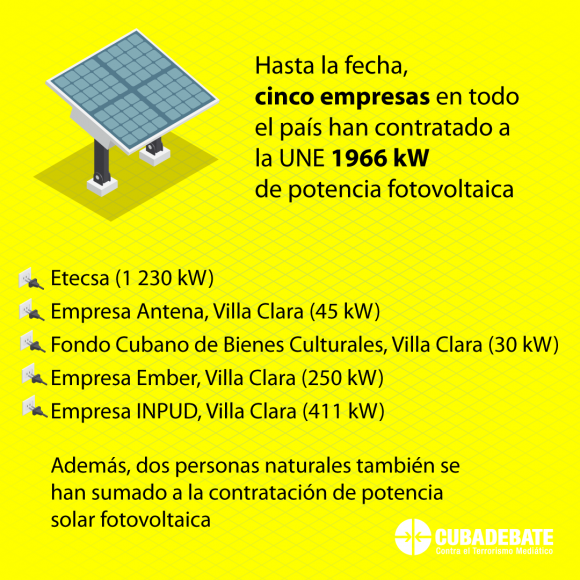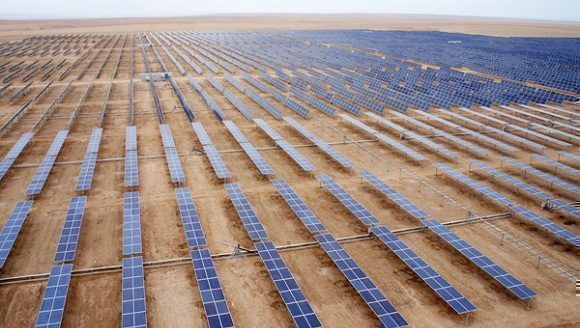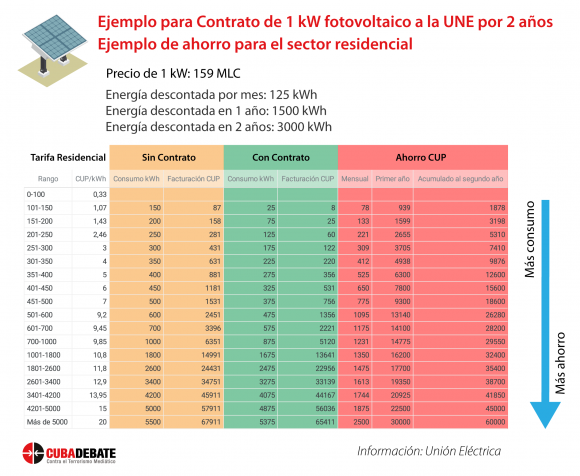
As part of the strategy carried out in Cuba for the development of renewable sources, the Ministry of Energy and Mines (Minem) approved a resolution at the end of 2021 that establishes the regulations for natural and legal persons to contract photovoltaic solar power to be self-sufficient. .
The document, published last December in the Official Gazette of the Republic, points out that both the residential and non-residential sectors can contract the power they want, which is installed in the country's photovoltaic solar parks.
Through a contract with the Electric Union (UNE), any person, company or private business can acquire, according to their needs and payment conditions, the photovoltaic power they want without the need to install a panel system in their premises, although there is also this last option.
“Except for payment, consumers do not make any other investment, so they do not have to deal with system installation, operation, maintenance, repair and protection. All this is carried out by the UNE, since the contracted photovoltaic systems are not physically in the entities or homes, but in the parks of the national electricity system”, says Ramsés Montes Calzadilla, director of energy policy and strategy of the Minem.
Now, for each kiloWatt (kW) contracted, the client will be deducted 125 kWh monthly during the term of the contract (two, five, 10 or 20 years).
"That amount is deducted from the electricity bill recorded by the meter meter of the home or company that contracted it, so that after a certain time the clients will recover their investment and obtain profits in economic matters."
In this sense, the specialist emphasizes that the objective of the acquisition of renewable energy sources is not to increase consumption, but to pay less. Likewise, he points out that it is a profitable option because, in addition to the benefits it currently provides, in the future the costs will surely go down, due to the fact that in the world photovoltaic solar technology shows a decrease in prices.
“The discount of the amount contracted -assures the manager- is not affected by cloudiness, bad weather or loss of efficiency of the panels over the years. In such a way that the client always receives the same discount per contracted kW”.
In the event that, taking into account monthly consumption, the contracted or acquired power generates surplus energy, the UNE will pay each kWh to the natural client at 3.00 CUP and to companies at 1.81 CUP. These prices are due to the fact that the rate for companies is lower than that of the residential sector.
Montes Calzadilla also points out that the project is not something new: "The whole world does it that way, and what Cuba did was adapt it to our conditions."
According to Minem resolution 242/2021, it can be contracted from 0.5 kW onwards, and the price varies depending on the power contracted and the number of years agreed upon.For example, if the customer contracts 1 kW for a period of 20 years, the price is 1,500 MLC; On the other hand, if you contract the same capacity for two years, the amount to be transferred is 159 MLC.
Steps to carry out the hiring Natural and legal persons may make transfers from their account in Freely Convertible Currency (MLC) to the MLC account created by the Electric Union in the International Financial Bank (BFI), for exclusive use for the development of photovoltaic energy. Before making the transfer, the consumer will appear at the commercial office to request participation in the generation of electricity through photovoltaic systems. You must present your identity card and proof of payment for the current month. The consumer, once the amount has been agreed at the commercial office, may make the transfer at the country's bank branches to the Electric Union's MLC account. The Electric Company will verify, through the bank, the completion of the deposit and will summon the consumer to sign the contract. This will begin to receive the benefits in the billing following the contracting of the service.
At high prices, greater savings?
For Montes Calzadilla, contracting is generally carried out by those who do not have the conditions to install the renewable energy system in their premises or prefer, due to the benefits that this modality brings, to opt for this route.
In this sense, any type of consumer with an MLC account can participate.In the almost two months since the resolution was published in the Official Gazette, five companies have contracted, as a whole, a total of 1,966 kW. ETECSA was the first, requesting 1,230 kW of photovoltaic power for 20 years, which represents almost two million MLC.
"This means that the company will be able to consume clean energy over the next 20 years for a value of 36,900 mWh, which avoids emitting 31,000 tons of carbon dioxide into the atmosphere," says the Minem specialist.
The company Antenas, from Villa Clara, is another of those that today join renewable sources through this route.
According to its general director, Ihosvany Orozco Muñoz, after studying the benefits and to contribute to the development of clean energy in Cuba, they decided to contract 45 kW of power for two years.
This amount, which is equivalent to 5,625 kWh per month, reports an approximate saving of 1.23 CUP per kWh for Antenas, achieving savings of more than 167,000 CUP in the two years contracted. This amount is beneficial for the efficiency indicators of the company and its workers, highlights the manager.
“We estimate to recover the investment in the first 11 months -says Orozco Muñoz-. We already obtained the benefit of the first month and from an invoice of 15,897.91 CUP, 13,108.50 were deducted; that is, we only paid 2,451.16 CUP”.On the other hand, in the residential sector only two people have taken advantage of this new possibility.Alexis Góngora Torres: “In two years I will be able to save 29,800 pesos”
For Alexis Góngora, the first of the two clients in the residential sector who have contracted photovoltaic power, this option brings him a benefit according to his consumption. Góngora Torres comments to Cubadebate that in December 2021 he contracted 2 kW for 2 years, at a cost of 318 MLC. If 125 kWh are deducted monthly for each contracted kW, Alexis has reduced her consumption in December and January by 250 kWh for each month.
–What advantages and disadvantages do you see in contracting photovoltaic energy?
“The first thing I recommend is to make an assessment of what amount of power is best for you to contract, always assuming that you have the initial payment capacity. The same benefit is not obtained by contracting 2 kW if your monthly consumption is 450 kW as if your consumption is 750 kW. The second thing is to be clear about whether what you want is to save money, that is, consume the same energy and pay less, or consume more energy without increasing your expenses. The analysis must be done.
“The comparison we made in the house inclined us to opt for this modality for many reasons. This type of service, in essence, replaces the execution of the physical investment, it being understood that it is not necessary to have a specific area: roof, plot, etc., for the location of the equipment. In time you can get the benefits faster.
“As fundamental disadvantages of the service contracting modality, it is that you do not have energy backup when service is affected, which may be possible by making your own investment and being clear that you are not the owner of the investment, even when you do. do for 20 years, which is the average useful life of these facilities”.
–What account did you get to know that hiring would give you a benefit? Because all consumers should not be given math…
“In our case, we made an assessment of energy consumption and its cost in the last two years, which ranged between 460 and 740 kW, with an average of 556 kW per month. At home we make a savings plan, especially in the summer limiting the use of household appliances and air conditioning, but even so, the resulting consumption continued to have a high cost, which together with food occupy almost the entire salary. . Hence the importance we gave to this opportunity for financial savings.
“With this background, we made the calculation of how many kW it would be advisable to contract and that of course we could pay. The result was that with 2 kW we could reduce billing by 6,000 kW in 2 years, representing an estimated saving, discounting the advance payment, of 29,800 pesos. The analysis must be done month by month, taking into account that it is a progressive price scale and not a linear price of energy.
“Already the first two months since the contracting has allowed us a real saving of 2,035 pesos, even though these months are the ones with the least consumption. I emphasize that in the month of January we only paid 53.73 pesos.
“On the analysis of why some consumers do not give an account, there are several aspects that may be influencing, at this time, the impossibility of accessing an exchange market adjusted to the official rate has a major influence. An informal market has been created with rates that are inaccessible to the majority of workers”.The fact that the hiring is done in MLC represents a point against some natural persons. However, taking the informal exchange rate as a reference and rounding it up to 100 CUP for each MLC, the mathematical calculation allows us to indicate that from 500 kWh of consumption, contracting represents a benefit.
"In Cuba there are around 180,000 customers who consume in that range," points out Montes Calzadilla, an official from the Ministry of Energy and Mines.
While the private sector carries out the process through a transfer of financing to an account in freely convertible currency (MLC) of the UNE, for companies with liquidity support (CL) it is more feasible. In this sense, the state entities have the option of doing so by means of a CL support to said company, at a rate of 24 CUP for each MLC, for which the amount financed is less than that of a natural person who goes to the exchange rate. informal.
On the other hand, the client has the possibility of establishing as many contracts as he wishes. If once the contract has been made, the consumer wants to request more kW in power, the resolution allows it. Likewise, the beneficiaries can transfer the contract to third parties.
What other ways exist to acquire photovoltaic energy, and what is the price?
Import of photovoltaic systems by self-employed workers, Mipymes and non-agricultural cooperatives through COPEXTEL and other companies dedicated to it. In the case of natural persons, they can import said technologies through companies such as CIMEX, SASA and Tiendas Caribe, or on their own, which is free of tariffs and without limits in terms of quantity in a calendar year.
Import of photovoltaic systems by self-employed workers, Mipymes and non-agricultural cooperatives through COPEXTEL and other companies dedicated to it. In the case of natural persons, they can import said technologies through companies such as CIMEX, SASA and Tiendas Caribe, or on their own, which is free of tariffs and without limits in terms of quantity in a calendar year.
Sale of photovoltaic systems through electronic commerce in CIMEX stores or COPEXTEL commercial offices in Havana, Camagüey and Ciego de Ávila.
In the case of CIMEX, the price is 2,500 MLC, and in the case of COPEXTEL, 55,000 CUP. Payment options include cash, electronic payment through the EnZona platform and bank check.
According to Susana Delgado Carrera, head of the Sales department of COPEXTEL's Business Division, the customer has the option of going to the stores in person or reserving the systems by phone, through the call center numbers of the division that offers them.
The official explains that, in all cases, the first step will be the compulsory free of charge technical visit of the marketer to the client's installation, to find out if their home or work entity meets the requirements for the installation.
What are these requirements?
The installation site (rooftop or ground) must be exposed to the sun throughout the year, without shade and clear; have an available area of 12.5m² and have a side with a minimum distance of 2.5m facing South.
In the case of the roof, it must be made of concrete (plate), and in the case of the floor, it must be paved (cemented or asphalted). They must support a weight of 12 kg per m² and preferably be horizontal or, failing that, in a way that allows the photovoltaic solar system to be levelled.
If the client does not wish to drill the plate for its anchoring with mechanical expansions, he must guarantee eight concrete cubes (cement) with an approximate weight of 20 kg each.
Once it is known that the premises are suitable for installation, the client must make the payment and agree with the marketing company on the time of installation. Subsequently, the latter will be in charge of moving the photovoltaic system to the arranged location.
Regarding the maintenance of the systems, whose useful life is 20 years, COPEXTEL guarantees it every six months with an additional cost to that of the installation. What if the power goes out?
The contracting of photovoltaic energy to the UNE does not exempt from the affectations of the electrical fluid. As for the systems installed at the customer's premises, there are three types, two of which also do not guarantee electricity during blackouts.
Ramsés Montes Calzadilla points out that, when the electricity goes out, the interconnected system – which is the one that is most used and offered – is disconnected.
"Why it happens? There is always the possibility that power from the panel will go into the system and, for example, if the system is without power and there is a lineman working, that power goes up through the transformer to the high voltage and kills the lineman. Therefore, there is an international norm that states that interconnected systems, when there is no energy in the network, cannot deliver energy. Then they disconnect, "says the director of the Minem.
Another of the systems, called hybrid, is also disconnected in these cases, but it does transmit electricity thanks to the battery that is included. The cost of the latter is very high.
According to Montes Calzadilla, the offer of all these options seeks to include economic actors and natural persons in the renewable energy development program in Cuba. This program aims to reach, in the year 2030, 37% of clean energy in the country.CUBADEBATE








Read more...